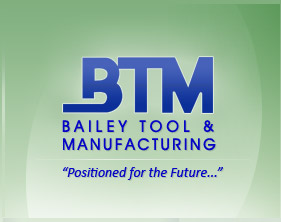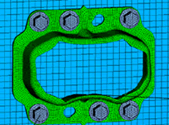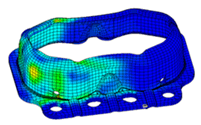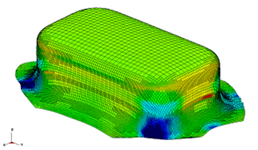 |
 |
 |
 |
 |
 |
 |
 |
Technology |
Materials ScienceCase Study: Advanced Product Design of Structural Components through Deformation ControlKey IssueAutomotive designers typically do not take advantage of the work hardening of the material during the forming process in subsequent structural analysis. As a result there are many interior structural components that are over-designed, resulting in increasing vehicle weight and/or cost of the component. Challenge
We were recently approached by one of our global Tier 1 customers to assist with re-design and development of truck mount shown below. The existing tool for the component made from 5.5 mm thick, Grade 80 HSLA steel was designed in Germany and prototype components were being made in Sweden, although the component would be used for assembly in North America. Bailey Tool's Approach and SolutionWe requested the loads that would be experienced by the component. Conducted FEA to determine the Von Mises stresses on the component without incorporating deformation induced strain hardening effect and realized that the maximum stress on the part was
Bailey then reverse engineered the part to determine the appropriate forming sequence and then conducted simulations to assess the extent of strain hardening on the part using the 80 KSi and a lower strength 50 KSi material at the 5.5mm starting thickness. Even with a 50 KSi material, the work hardening at the corners results in increasing material yield strength to 100 KSi and thickens the corners to about 6.5-7 mm. ConclusionAfter incorporating strain hardening effect, Bailey Tool demonstrated to the customer that it would be feasible to specify the part from a lower strength 50 KSi material and even specify a lower starting thickness to minimize cost, improve manufacturability, while meeting the functional requirements.
|
Copyright © 2008 Bailey Tool & Manufacturing | Site by Visual App

 60% of the initial yield strength of the material and therefore perhaps validated the original design.
60% of the initial yield strength of the material and therefore perhaps validated the original design.
